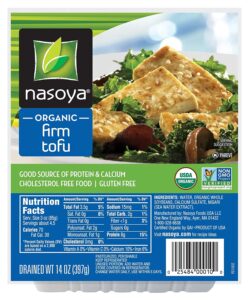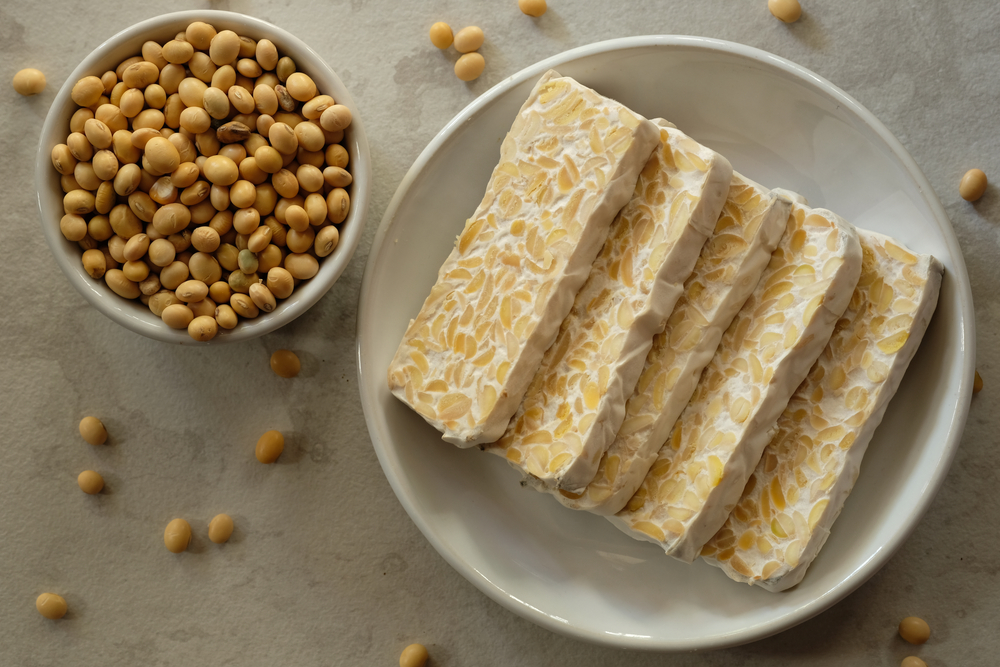Plant-based diets are on the rise. With more people opting for less meat, plant-based protein sources, such as tempeh, are popping up more frequently. For those following a gluten-free diet, is tempeh a gluten-free meat alternative?
Traditional tempeh is gluten-free as it is made from only soybeans and vinegar. However, many store-bought forms of tempeh contain wheat. If you are looking for gluten-free tempeh, Lightlife, Soy Boy, and Mari Gold Health Foods all offer gluten-free tempeh. The best gluten-free alternatives to tempeh include Nasoya Organic Tofu, Anthony’s Textured Vegetable Protein, and Butler Foods Soy Curls.
Now that we know some tempeh options can be gluten-free, let’s take a deeper look into tempeh, its health benefits and some of the top-rated gluten-free alternatives on the market.
Contents
What is Tempeh
Those on a plant-based diet are most likely familiar with tempeh but for those of us who aren’t vegan or vegetarian, it may seem very foreign. Tempeh is a fermented soy product that is commonly used as a plant-based protein alternative or meat replacement. Tempeh consists of fermented soybeans that are then pressed together into a cake that sometimes contains wheat. It has a slightly chewy texture and nutty flavor.
Health Benefits of Tempeh
Tempeh is a rich source of many nutrients. Because of the fermentation processed, tempeh is a good source of probiotics as well. These are the beneficial bacteria that support a healthy gut and digestion. Tempeh is also a good source of prebiotics, the fiber needed to support the growth of probiotics [1].
Tempeh is best known for being an excellent plant-based protein source. Protein is essential for satiety and high protein diets have been associated with increased fullness and decreased hunger. Plant-based proteins are associated with decreased cholesterol and triglyceride levels compared to animal proteins. A lot of this is attributed to the low saturated fat content and isoflavones present in soy [2, 3].
Nutrition Facts for Traditional Tempeh
Nutrition Facts (Per 3-ounces):
- Calories 160
- Fat 9g
- Saturated fat 0g
- Sodium 9mg
- Carbohydrates 9g
- Sugar 0g
- Added sugar 0g
- Fiber 0g
- Protein 15g
Gluten-Free Tempeh Brands
Lightlife Original Tempeh
Made with fermented soybeans, water, and brown rice, Lightlife original tempeh is suitable for those on a gluten-free diet. This product is also non-GMO and USDA certified organic. You can find Lightlife original tempeh in store or online at various retailers, including Target, priced at $3.19 for an 8-ounce package.
Ingredients:
- Cultured organic soybeans
- Soybeans
- Lactic acid from plant source
- Water
- Organic brown rice
Nutrition Facts (Per 3-ounces):
- Calories 160
- Fat 4.5g
- Saturated fat 0.5g
- Sodium 0mg
- Carbohydrates 12g
- Sugar 0g
- Added sugar 0g
- Fiber 6g
- Protein 18g
Soy Boy Organic Soy Tempeh
Certified USDA organic, non-GMO, gluten-free and free of additives, Soy Boy organic soy tempeh is a great source of fiber and contains minimal ingredients. You can find this product online at soyboy.com priced at $3.29 for an 8-ounce package.
Ingredients:
- Organic soybeans
- Filtered water
- Organic white distilled vinegar
- Tempeh culture
Nutrition Facts (Per 3-ounces):
- Calories 150
- Fat 6g
- Saturated fat 1g
- Sodium 0mg
- Carbohydrates 8g
- Sugar 0g
- Added sugar 0g
- Fiber 5g
- Protein 16g
Mari Gold Health Foods Gluten-Free Fermented Vegan Tempeh Slices
Gluten-free and easy to use, Mari Gold Health Foods fermented Tempeh Slices are limited ingredient, ready-to-eat, low in sodium and rich in fiber. You can find this product online at Amazon.com priced at $16.63 for a 170 gram can.
Ingredients:
- Soybeans
- Culture (rhizopus oligosporus)
- Water
- Sea salt
Nutrition Facts (Per 100 grams):
- Calories 160
- Fat 6g
- Saturated fat 1g
- Sodium 0mg
- Carbohydrates 3g
- Sugar 0g
- Added sugar 0g
- Fiber 9g
- Protein 19g
Gluten-Free Alternatives to Tempeh
Nasoya Organic Super Firm Tofu
 One of the most popular, gluten-free, plant-based alternatives to tempeh is tofu. Also made with soybeans, Nasoya organic super firm tofu is nutritious, rich in protein and versatile. You can find this product in store or online at various retail sites, including Publix, priced at $3.75 for a 1-pound block.
One of the most popular, gluten-free, plant-based alternatives to tempeh is tofu. Also made with soybeans, Nasoya organic super firm tofu is nutritious, rich in protein and versatile. You can find this product in store or online at various retail sites, including Publix, priced at $3.75 for a 1-pound block.
Ingredients:
- Water
- Organic soybeans
- Less than 2%
- Magnesium chloride
- Calcium sulfate
Nutrition Facts (Per 0.2 piece):
- Calories 130
- Fat 7g
- Saturated fat 1.5g
- Sodium 10mg
- Carbohydrates 2g
- Sugar 0g
- Added sugar 0g
- Fiber 2g
- Protein 14g
Anthony’s Organic Textured Vegetable Chunks and Pieces
 Often abbreviated TVP, Anthony’s organic textured vegetable chunks and pieces are made from organic soy flour, also known as textured vegetable protein. They are Gluten-free, USDA certified organic, non-GMO and versatile in many recipes. You can find this product online at Amazon.com priced at $11.99 for a 1-pound bag.
Often abbreviated TVP, Anthony’s organic textured vegetable chunks and pieces are made from organic soy flour, also known as textured vegetable protein. They are Gluten-free, USDA certified organic, non-GMO and versatile in many recipes. You can find this product online at Amazon.com priced at $11.99 for a 1-pound bag.
Ingredients:
- Organic soy flour
Nutrition Facts (Per ¼ cup):
- Calories 45
- Fat 1g
- Saturated fat 0g
- Sodium 0mg
- Carbohydrates 3g
- Sugar <1g
- Added sugar 0g
- Fiber 1g
- Protein 6g
Butler Foods Soy Curls
 Made with whole, non-GMO soybeans, Butler Foods soy curls are gluten-free and free from additives and preservatives. They are easily rehydrated for cooking and are convenient and versatile in many recipes. You can find this product online at Amazon.com priced at $8.24 for an 8-ounce package.
Made with whole, non-GMO soybeans, Butler Foods soy curls are gluten-free and free from additives and preservatives. They are easily rehydrated for cooking and are convenient and versatile in many recipes. You can find this product online at Amazon.com priced at $8.24 for an 8-ounce package.
Ingredients:
- Textured whole soybeans
Nutrition Facts (Per ¾ cup):
- Calories 100
- Fat 4.5g
- Saturated fat 0g
- Sodium 0mg
- Carbohydrates 5g
- Sugar 1g
- Added sugar 0g
- Fiber 3g
- Protein 10g
All-Natural Gluten-Free Alternatives to Tempeh
For those looking for gluten-free, plant-based meat alternatives that take a more natural approach, consider using jackfruit or mushrooms. With a similar, meaty texture, these items can replace tempeh or meat in a variety of dishes.
Native Forest Organic Young Jackfruit
Although it is not as protein rich as tempeh, jackfruit can simulate the texture of shredded meats and work well as an alternative protein for tacos, casseroles and more. Jackfruit is mild in flavor, similar to tempeh and tofu, and takes on the flavors of its seasonings.
Native Forest organic young jackfruit is a convenient plant-based alternative. For those looking to cut out the additional salt or choose a slightly less processed approach, try grabbing a jackfruit in the store. To obtain the meat of the jackfruit it needs to be boiled and then peeled to reveal the seed pods. The seed pods can be eaten once the seeds are removed, along with the flesh surrounding the seed pod.
For those who have never tried jackfruit before, a pre-prepared version may be best to start. You can find this product online at Amazon.com priced at $73.99 for a set of 12 14-ounce cans.
Ingredients:
- Organic young jackfruit
- Water
- Sea salt
- Organic lime juice
Nutrition Facts (Per ½ cup):
- Calories 40
- Fat 0g
- Saturated fat 0g
- Sodium 840mg
- Carbohydrates 9g
- Sugar 0g
- Added sugar 0g
- Fiber 7g
- Protein 2g
Shiitake Mushrooms
Similar to jackfruit, Shiitake mushrooms are not a good source of protein. However, they have a mild flavor and a meaty texture that makes them great as a plant-based meat alternative. Rich in nutrients yet inexpensive, Shiitake mushrooms can work well as a naturally gluten-free substitute for tempeh. You can find Shiitake mushrooms at most retail grocers, including Walmart and Publix, priced at $3.98 for a 3.2-ounce container.
Ingredients:
- Shiitake mushrooms
Nutrition Facts (Per 1 whole):
- Calories 6
- Fat 0g
- Saturated fat 0g
- Sodium 2mg
- Carbohydrates 1g
- Sugar 0.5g
- Added sugar 0g
- Fiber 0.5g
- Protein 0.5g
Homemade Tempeh Recipe
For those interested in making their own tempeh, you will be surprised to learn how easy it can be. Remember, if making your own tempeh at home, always be sure to cook your tempeh before eating it to eliminate risk of foodborne illness.
Ingredients:
- 1-pound dried, whole soybeans
- 2 tablespoons white vinegar
- 1 teaspoon tempeh starter
Instructions:
- Place soybeans in a large bowl and cover completely with water to soak overnight, or at least 12 hours.
- Once the beans have soaked, remove the hulls, the outer skins surrounding the beans. You can do this with your hands or a potato masher to loosen the skins. The hulls will float to the surface where they can be skimmed from the water and discarded.
- Drain and transfer hulled beans to a large pot with fresh water. Boil then reduce heat to simmer, partially covered, until beans are tender (about 45 minutes.)
- Take 2 Ziploc bags and pierce a hole in 1-inch intervals using a toothpick or skewer.
- Once beans are done cooking, drain and spread them out to dry on a towel-lined baking sheet until they are cool.
- Transfer dried and cooled beans to a clean bowl and sprinkle with vinegar until evenly coated.
- Next sprinkle tempeh starter over the beans and evenly distribute.
- Separate and place your beans in the two Ziploc bags, seal and flatten evenly.
- Bags must be incubated between 85-90 degrees Fahrenheit for 24-48 hours.
- The tempeh is done when the surface is covered completely with a layer of white mycelium.
- Remove from heat and let cool.
- Store in refrigerator for up to 1 week.
Related Questions
Is Tempeh Supposed to Look Moldy?
Mold spots on your tempeh are a byproduct of the fermentation process. These may look like small, dark spots on the surface and are completely normal and edible. They do not affect the flavor or safety of the product.
Does Tempeh Need to be Cooked?
If you purchase your tempeh from the grocery store and it is pasteurized, it does not need to be cooked. Unpasteurized tempeh or homemade tempeh should always be cooked to reduce risk of foodborne illness.
Can Tempeh Spoil?
Yes, once opened tempeh can continue to grow mold and spoil. The best way to tell if your tempeh has gone bad is to feel the texture and use your sense of smell. A slimy texture and off-putting odor are your biggest indicators that it’s time to toss the tempeh.
